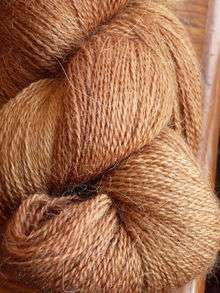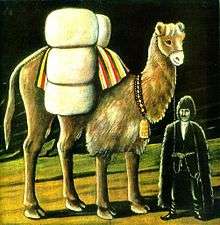Cameline

Cameline (/ˈkæməliːn/ KAM-ə-leen) was a fabric material used in the Middle Ages for cloth.[1] By tradition it is commonly thought to have been originally made of camel's hair in Asia.[1] It was imported from Cyprus and Syria into Europe.[2] Cameline is described also as a cloak of the Arabs made of camel's hair which is oftentimes striped white and brown in color.[3] Since history records it many times as a "common and cheap" textile it is thought that it was an imitation of the original Asian camel's hair fabric.[1] It was sometimes a lower quality French cloth imitation made of goat's hair.[4] The fibers were spun into yarn and produced in Flanders and the Duchy of Brabant in many colors in medieval times. It is also described as a warm light woolen textile of camel's hair combined with wool or cotton. It is considered of lesser quality than that of camlet, which is also made of camel's hair.[5]
Cameline is described in textile dictionaries as a coarse medieval fabric. The cloth of camel's hair is sometimes used in combination with other fabrics and made into a twill weave pattern or a basket weave which is finished with a soft nap. It is said to have been used in woolen clothing articles similar to cashmere wool clothing. Some authorities even think cameline is the same as we call today cashmere.[1][6][7]
Etymology
Middle English, from Old French camelin, from camelus, pertaining to a camel.[8] From Old Italian of cammellino, Middle Latin of camelinuw, also camelinus – a textile made from camel's hair.[9]
Cambolism seems to be recorded in Old French and English as the same as cameline. It is described as a brown cloth supposedly made of camel's hair, similar to that of camlet.[10] Marco Polo records in his notes camlets made at Ninghaia with camel's hair in the 13th century. Chou Ch'il-fei in 1178 records of camel's hair satin camlets of many colors.[11]
The name Camplin and Campling is defined as a wearer or maker of cameline.[12]
History
Cameline materials were made in the thirteenth century at Saint-Quentin, Aisne in France. Various types and colors were also made in the fourteenth century in Amiens, Brussels, Cambrai, Commercy, and Mechlin.[5] History records its first documented use in 1284.[2] The medieval chronicler of France Jean de Joinville recollects that "the king (Louis IX) sent me to Tortosa, and commissioned me to purchase for him one hundred camelines of divers colors, to give to the Cordeliers when they returned to France." In this recollection he says there was a wide range of qualities and prices.[13] He also records cameline camel's hair cloth being made at Cambrai and Amiens.[14]
Such a clothing material is described by Geoffrey Chaucer in his 13th-century Romaunt of the Rose.[15]
And Dame Abstinence-Streyned
Toke on a robe of kamelyne,
And gan hir (graithel) as a Bygyne.
The cloth was ryche and rygt fyn,
The champe it was of red kamelyne.
Usage

In medieval times originally the best quality of the camel's hair was used to make rich and luxurious articles of clothing. The coarser type of the cloth was used for the covering of tents. This coarse cloth was also used in medieval times for the upper garments of shepherds and camel drivers along with a leather girdle. Camel drivers of today sometimes still use this type of clothing.[16]
Wycliffe's Bible quotes Matthew 3:4 in Middle English as:
And this Joon hadde clothing of camels heeris, and a girdil of skynne aboute hise leendis; and his mete was honysoukis, and hony of the wode.[17]
A modern English version of this same passage reads:
And this John had clothing of camel's hairs, and a girdle of skin about his loins; and his meat was honeysuckles and honey of the wood.[18]
Wycliffe's Bible quotes Mark 1:6 in Middle English as:
And Joon was clothid with heeris of camels, and a girdil of skyn was about hise leendis; and he ete hony soukis, and wilde hony.[19]
A modern English version of this same passage reads:
And John was clothed with hairs of camels, and a girdle of skin was about his loins; and he ate honeysuckles, and wild honey.[20]
According to the Old Testament camel's hair weave was made into cloth and the clothing referred to as cameline garments and worn by Persian priests.[21]
2 Kings 1:8 refers to "a man dressed in hair" which scholars believe to be camel's hair.[22]
And they answered him, He was an hairy man, and girt with a girdle of leather about his loins. And he said, It is Elijah the Tishbite.[23]
Footnotes
- 1 2 3 4 Cole, pp. 54,55 Cameline (cam'-e-lin). A fabric used centuries ago as a material for dress. It is commonly said to have been made of camel's hair; but as it is repeatedly in old invoices mentioned as a cheap stuff, it is probable that it was an imitation of the genuine Eastern fabric. Some authorities think this fabric was identical with what we now call Cashmere.
- 1 2 Nunn, p. 28
- ↑ Balfour, p. 558
- ↑ English 18th century dances, Volume 3, p. 107
- 1 2 NAWM, p. 137
- ↑ Harmuth, p. 30 Cameline: a coarse medieval fabric, made of camel hair in twill weave, similar to the cashmere.
- ↑ Cameline
- ↑ Hunter, p. 27
- ↑ Whitney, p. 776
- ↑ Barbosa, p. 63
- ↑ Pelliot, p. 144
- ↑ Reaney, p. 82
- ↑ Planche, p. 72
- ↑ Bell, p. 109
- ↑ Dahlberg, p. 305
- ↑ Packard, p. 129
- ↑ Wycliffe's Bible Matheu Chapter 3
- ↑ Matthew 3:4 (Wycliffe New Testament)
- ↑ Wycliffe's Bible Mark Chapter 1
- ↑ Mark 1:6 (Wycliffe New Testament)
- ↑ Rivington, p. 468
- ↑ Goodhugh, p. 241
- ↑ 2 Kings 1:8 (King James Version)
References
- Balfour, Edward, The cyclopædia of India and of eastern and southern Asia, Vol. 1, B. Quaritch, 1885
- Barbosa, Duarte, The book of Duarte Barbosa: an account of the countries bordering on the Indian Ocean and their inhabitants, Asian Educational Services, 1996, ISBN 81-206-0451-2
- Bell, J., La Belle assemblée, Volume 5, J. Bell, 1812
- Cole, George S., A complete dictionary of dry goods and history of silk, cotton, linen, wool and other fibrous substances..., W. B. Conkey company, 1892
- Dahlberg, Charles, Volume 7 of Variorum Edition of the Works of Geoffrey Chaucer (The romaunt of the rose), University of Oklahoma Press, 1999, ISBN 0-8061-3147-0
- English 18th century dances, Volume 3, 1813, Original from the New York Public Library
- Harmuth, Louis, Dictionary of textiles, Fairchild publishing company, 1915
- Hunter, Robert, The encyclopaedic dictionary: a new original work of reference to all the words in the English language, with a full account of their origin, meaning, pronunciation, and use ..., Cassell, Petter, Galpi & Co., 1882
- Goodhugh, William, The Bible cyclopædia: or, Illustrations of the civil and natural history of the sacred writings, 1841
- NAWM – National Association of Wool Manufacturers, Bulletin, Volume 23
- Nunn, Joan, Fashion in costume, 1200–2000, New Amsterdam Books, 2000, ISBN 1-56663-279-X
- Packard, Frederick Adolphus, The union Bible dictionary: for the use of schools, Bible classes, and families, American Sunday-school union, 1855
- Pelliot, Paul, Notes on Marco Polo, Impr. nationale, 1959
- Planche, James Robinson, A cyclopedia of costume or dictionary of dress, 1876
- Reaney, Percy Hide, A dictionary of English surnames, Psychology Press, 1991, ISBN 0-415-05737-X
- Rivington, C. & J., The Quarterly theological review and ecclesiastical record, Volume 1, C. & J. Rivington, 1825
- Royal Geographical Society (Great Britain), The journal of the Royal Geographic Society of London, Volume 5, J. Murray, 1835
- Whitney, William Dwight, The Century dictionary and cyclopedia Volume 1, The Century Company, 1906